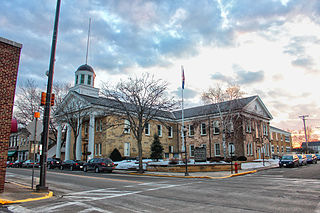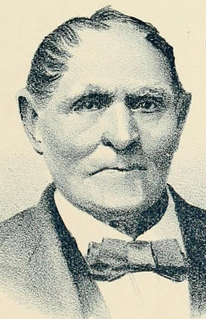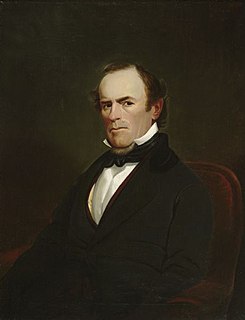Related Research Articles

Iowa County is a county in the U.S. state of Wisconsin. As of the 2010 census, the population was 23,687. Its county seat and largest city is Dodgeville. When created, it was part of the Michigan Territory. Iowa County is part of the Madison, Wisconsin, Metropolitan Statistical Area.

Mineral Point is a city in Iowa County, Wisconsin, United States. The city is located within the Town of Mineral Point. Mineral Point is part of the Madison Metropolitan Statistical Area. Wisconsin's third oldest city, Mineral Point was settled in 1827, becoming a lead and zinc mining center during the 19th and early 20th centuries. In the mid-twentieth century it attracted artists. Today the city's preserved historical character within the varied topography of the driftless area has made it a regional tourist destination. The population was 2,581 at the 2020 census.

Moses Henry Dodge was a Democratic member of the U.S. House of Representatives and U.S. Senate, Territorial Governor of Wisconsin and a veteran of the Black Hawk War. His son was Augustus C. Dodge with whom he served in the U.S. Senate, the first, and so far only, father-son pair to serve concurrently. Henry Dodge was the half brother of Lewis F. Linn. James Clarke, the Governor of Iowa Territory was his son-in-law.

Columbia Lancaster was an American lawyer and politician who served as the first Delegate from the Territory of Washington to the United States House of Representatives.
The Sinsinawa Mound raid occurred on June 29, 1832, near the Sinsinawa mining settlement in Michigan Territory. This incident, part of the Black Hawk War, resulted in the deaths of two men; a third man survived by seeking cover in a nearby blockhouse. In the aftermath of the raid, Captain James W. Stephenson set out to pursue the attackers—a straggling band of Sauk Native Americans—but lost their trail at the Mississippi River. The attack occurred in the same week as other skirmishes and raids, and as a result helped contribute to the growing fear in the region. The raid caused the residents of nearby Platteville to consider fleeing their settlement.

Fort Defiance was one of the last garrisoned stockade forts constructed in territorial Wisconsin. It was located approximately five miles southeast of Mineral Point, Wisconsin. It was located in the booming lead mining region in an area of early settlement. The fort was built by local settlers in 1832 when developing tensions over Native American land rights erupted into the Black Hawk War. Although Fort Defiance did not experience attack, it did have a garrison of about 40 militia men who were said to be among the best drilled in the territory. Fort Defiance had two blockhouses located at opposite corners of the stockade. Within the walls were two buildings used to accommodate the garrison and the families of settlers in case of a siege. There are no visible remains.
William Stephen Hamilton, a son of Alexander Hamilton and Elizabeth Schuyler Hamilton, was an American politician and miner who lived much of his life in the U.S. state of Illinois and the Wisconsin Territory. Hamilton was born in New York, where he attended the United States Military Academy before he resigned and moved to Illinois in 1817. In Illinois he lived in Springfield and Peoria and eventually migrated to the lead-mining region of southern Wisconsin and established Hamilton's Diggings at present-day Wiota, Wisconsin. Hamilton served in various political offices and as a commander in two Midwest Indian Wars. In 1849 he moved to California during the California Gold Rush. He died in Sacramento, most likely of cholera, in October 1850.

Levi Sterling was an American farmer, politician, and Wisconsin pioneer. He was one of the first American settlers at what is now Iowa County, Wisconsin. He served five years in the Wisconsin Legislature and—before Wisconsin achieved statehood—he served three years in the Wisconsin Territorial Assembly. During the American Civil War, he served as a Union Army cavalry officer.

John Wilford Blackstone Sr. was an American lawyer and Wisconsin pioneer. He was Speaker of the Legislative Assembly of the Wisconsin Territory, and served as County Judge of Iowa County, when it was still organized under the Michigan Territory.
John B. Terry was an American pioneer, merchant, soldier, and territorial legislator.
Charles Chandler Hascall was an American newspaper publisher and politician. He served in the Michigan Senate during its first session after adoption of the state constitution.
George Howe was an American politician who served in the Michigan House of Representatives immediately after adoption of the state's first constitution.

The Sixth Michigan Territorial Council was a meeting of the legislative body governing Michigan Territory, known formally as the Legislative Council of the Territory of Michigan. The council met in Detroit in two regular sessions, one extra session, and one special session between January 7, 1834, and August 25, 1835, during the terms of George B. Porter and Stevens T. Mason as territorial governors.
The Michigan Territorial Council, known formally as the Legislative Council of the Territory of Michigan, was the legislative body of the Territory of Michigan from 1824 to 1835, when it was succeeded by the Michigan Legislature in anticipation of Michigan becoming a U.S. state. A session of the council including only members from what would become Wisconsin Territory met in 1836.
The Seventh Michigan Territorial Council, also known as the Rump Council, was a meeting of the legislative body governing Michigan Territory in January 1836, during the term of Acting Governor John S. Horner. At the time, most of Michigan Territory was awaiting admission to the union as the state of Michigan and had already seated its new state legislature. This was the final session of the Council and consisted only of members from the "contingent remainder" or "rump territory"—the remaining counties that formed the new Wisconsin Territory later that year.

The Fifth Michigan Territorial Council was a meeting of the legislative body governing Michigan Territory, known formally as the Legislative Council of the Territory of Michigan. The council met in Detroit in two regular sessions between May 1, 1832, and April 23, 1833, during the term of George B. Porter as territorial governor.
The Fourth Michigan Territorial Council was a meeting of the legislative body governing Michigan Territory, known formally as the Legislative Council of the Territory of Michigan. The council met in Detroit in two regular sessions between May 11, 1830, and March 4, 1831, during the terms of Lewis Cass and George B. Porter as territorial governor.
The Third Michigan Territorial Council was a meeting of the legislative body governing Michigan Territory, known formally as the Legislative Council of the Territory of Michigan. The council met in Detroit in two regular sessions between May 5, 1828, and November 5, 1829, during the term of Lewis Cass as territorial governor.
Thomas McKnight was an American from Mineral Point, Wisconsin Territory who served in the 1st Wisconsin Territorial Assembly. He served in the House of Representatives at the same time as Thomas McKnight of Dubuque in the Iowa District was serving in the Council.
Lucius H. Langworthy was an American lead miner, businessman, banker and local politician from Dubuque, Iowa who held public office in Michigan Territory, Wisconsin Territory and Iowa Territory.
References
- ↑ "Died. Hoard". Mineral Point Tribune May 15, 1867
- ↑ Crawford, George and Crawford, Robert M. Memoirs of Iowa County, Wisconsin From the Earliest Historical Times Down to the Present Northwestern Historical Association, 1913; p. 59
- ↑ History of Green County, Wisconsin. Together with Sketches of Its Towns and Villages, Educational... etc. Springfield, Illinois: Union Publishing Company, 1884; p. 148
- ↑ footnote to: Letter, Robert C. Hoard to John S. Horner, in Historical Collections and Researches Made by the Michigan Pioneer and Historical Society Vol. 37. Lansing: Wynkoop, Hallenbeck, Crawford Co., 1909-1910; p. 374
- ↑ "Muster Roll of Captain Robert C. Hoard Company, of Iowa Militia..." Turning Points in Wisconsin History > Wisconsin Muster Rolls from the Black Hawk War, 1832 Wisconsin Historical Society website; accessed November 28, 2021
- ↑ Memoirs of Iowa County... p. 59
- ↑ Letter, Robert C. Hoard to John S. Horner, in Historical Collections and Researches Made by the Michigan Pioneer and Historical Society Vol. 37. Lansing: Wynkoop, Hallenbeck, Crawford Co., 1909-1910; p. 374
- ↑ Memoirs of Iowa County... p. 68
- ↑ Memoirs of Iowa County... p. 47
- ↑ History of Green County, Wisconsin. Together with Sketches of Its Towns and Villages, Educational... etc. Springfield, Illinois: Union Publishing Company, 1884; pp. 455, 456
- ↑ "Died. Hoard". Mineral Point Tribune May 15, 1867